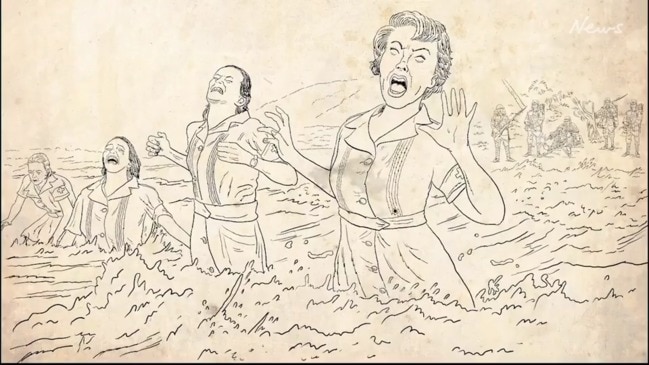Nurse Vivian Bullwinkel’s brave story commemorated with Australian War Memorial statue
A statue of nurse Vivian Bullwinkel, who was shot by Japanese soldiers in a wartime massacre and survived years in a PoW camp before inspiring generations of nurses, has been unveiled

READING LEVEL: ORANGE
Nurses who lost their lives, experienced wartime horrors and served their nation are now permanently commemorated* after a statue of Lieutenant Colonel Vivian Bullwinkel was unveiled on Wednesday at the Australian War Memorial.
The nurse and midwife, who served during World War II, is the first woman to be immortalised* in bronze at the memorial in Canberra.
Her story is remarkable and filled with bravery.

Lt Col Bullwinkel, who was born in December 1915 at Kapunda, South Australia, was at first rejected from the air force for having flat feet. However she tried again and successfully joined the Australian Army Nursing Service in 1941, a few months before her 26th birthday.
She was sent to Singapore and joined the 13th Australian General Hospital.
Within months, Lt Col* Bullwinkel was forced to flee because Japanese troops were advancing towards Singapore.

On February 12, 1941, Lt Col Bullwinkel and 65 other nurses boarded the SS Vyner Brooke to escape the island.
Two days later, the ship was sunk by Japanese aircraft. Lt Col Bullwinkel, 21 other nurses and a large group of men, women, and children made it to shore on Banka Island. They were joined the next day by about 100 British soldiers.
Japanese soldiers came and killed the men, then motioned for the nurses to wade* into the sea before they shot them with machine-guns from behind. Lt Col Bullwinkel was struck by a bullet in her back and pretended to be dead until the Japanese left. Her 21 nursing colleagues died around her. It became known as the Banka Island massacre*.

She hid with a wounded British soldier for 12 days before deciding to surrender. She spent three and a half years locked up in a Prisoner of War (PoW) camp before being freed.
After retiring from the army in 1947, she became director of nursing at Melbourne’s Fairfield Hospital.
She devoted her life to nursing and spent years honouring those killed on Banka Island, raising funds for a nurses’ memorial and also served as the first woman on the Australian War Memorial council.
Lt Col Bullwinkel, whose married name was Statham, died on July 3, 2000, aged 84.

The bronze sculpture, crafted by Brisbane-based artist Dr Charles Robb, has Lt Col Bullwinkel
placed to one side of her bronze pedestal, revealing a rippling surface in which 21 inlaid* silver discs reflect the victims of the Banka Island massacre.
Memorial director Matt Anderson said Lt Col Bullwinkel’s name should be known in all households, as should the story of her inspirational life.
Australian College of Nursing chief executive Kylie Ward said it was inspiring that generations of children would see a figure of a nurse and midwife at the national memorial.
“The sculpture will be a powerful and long-lasting symbol of nurses’ selfless* service to Australia and its citizens whether in war or in peace,” she said.

POLL
GLOSSARY
- commemorated: to remember and show respect
- immortalised: made famous so someone is remembered for a long time
- Lt Col: a rank in the Australian armed forces responsible for the operations of their unit
- wade: to walk through water
- massacre: the brutal killing of many people
- inlaid: sitting inside but flush with the surface
- selfless: concerned more with the needs and wishes of others than with one’s own
EXTRA READING
Equal pay pioneer honoured in bronze
World’s first statue of female cricketer at SCG
How a book saved this Aussie soldier’s life
QUICK QUIZ
1. Where is Lt Col Bullwinkel’s statue on display?
2. How many years did she serve in the armed forces?
3. What was the name of the island where the massacre took place.
4. What does PoW stand for?
5. What role did she hold later in life that was a first for a woman?
LISTEN TO THIS STORY
CLASSROOM ACTIVITIES
1. Remember Them
Use your research skills to find the names of the 21 nurses who died in the Banka Island massacre. Design a special poster that will help other kids learn about these women and remember them.
Time: allow at least 60 minutes to complete this activity.
Curriculum Links: English, History.
2. Extension
Why do you think it has taken so long for the first woman to be honoured with a statue at the Australian War Memorial? Write down your ideas on this question.
Time: allow 15 minutes to complete this activity.
Curriculum Links: English, History, Civics and Citizenship.
VCOP ACTIVITY
1. BAB it!
Show you have read and understood the article by writing three sentences using the connectives “because’’, “and”, and “but” (BAB). Your sentences can share different facts or opinions, or the same ones but written about in different ways.

